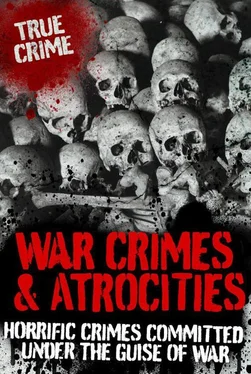The Italian air force used bombs and grenades to drop the gas on their targets, also spraying entire villages with it. Flame-throwers were also used to ignite whole rural areas. Mussolini himself ordered the attacks as a solution to the problem of reaching enemy hideouts in the hills. The Italian government tried to keep these operations secret, but the International Red Cross and foreign journalists denounced their use of chemical warfare, in particular, the bombing of hospitals and Red Cross headquarters in the country. Mussolini’s reaction to this criticism was that the Red Cross zones had been bombed by mistake, but since the bombings had occurred up to 20 times, this seemed unlikely.
MUTILATED BODIES
Not only was Italy’s use of chemical weapons condemned, but there was also intense criticism of the way prisoners of war were treated. Mussolini had given orders that all rebels taken alive were to be shot, whether soldiers or civilians, so as to prevent counter-attack. There were stories of Italian soldiers killing and mutilating enemy corpses in the most horrible ways, including throwing individuals out of aircraft as they were flying along. The victors often had their photographs taken next to piles of corpses, or beside public gallows where hanged men and women were strung up. In addition, the Italians set up forced labour camps around the country, not only terrorizing the population but exploiting them as well.
In 1937, there was an assassination attempt on General Rodolfo Graziani, one of the leading generals in the campaign, at a public ceremony in Addis Ababa. In retaliation, the Italian military immediately had the 30 Abyssinians present impaled before launching an attack on the rest of the population, rampaging through the streets of the city killing men, women and children, and setting fire to buildings. The attack ended with the rounding up and mass execution of hundreds of ordinary citizens.
TRIBAL PERSECUTION
Eventually, the Italians won the war in Abyssinia, and annexed the country, proclaiming the Italian king, Victor Emmanuel III, the new emperor. They went on to merge the country with Eritrea and Somaliland, forming a single new colony, Italian East Africa. The new colony was short-lived, and was broken up at the end of World War II, but the colonization created rivalries and conflicts among the tribes there that were to last for the rest of the twentieth century.
After the defeat, the exiled emperor, Haile Selassie, gave an impressive speech on 30 June, 1936, to the League of Nations, chastising them for having done nothing to aid his country in its time of need and warning, ‘It will be you tomorrow’. His speech turned out to be prophetic, as Adolf Hitler began to build National Socialism in Germany, ready to launch the evil of Nazi fascism on Europe.
Mussolini’s fascist regime in Ethiopia, as Abyssinia later became known, was nowhere near as brutal as that of the German Nazis under Adolf Hitler, but nevertheless the population suffered under the Italians. In particular, the Amhara people living in the central highlands, who had remained loyal to Haile Selassie, were persecuted by the Italians. There were strict laws against miscegenation – that is, intermarrying between different races – and all activities were strictly controlled by the colonizers. However, the Italians did make some improvements, including building a network of roads through the mountainous terrain, which had never been done before.
During the years of occupation, there were numerous resistance attempts, including a revolt in 1938 at Gojjam, led by some of the educated elite of the nation. Exiled in Britain, Emperor Haile Sellasie tried to gain support among the Allied powers for an invasion of the country, but met with little enthusiasm. However, once Italy joined forces with Germany in June 1940, the position changed, and a campaign was launched to eject the Italians from the region, masterminded by Haile Selassie, who moved his operation to Khartoum to liaise between resistance forces in the country and British troops outside it. In 1941, after the East African Campaign in which hundreds of soldiers from Ghana, Nigeria, South Africa and India took part, Ethiopia was finally liberated from the Italians and Emperor Haile Selassie resumed control.
WAR CRIMINALS
After the war, the brutality of the Italian invasion of Ethiopia became known, and there were calls for those involved to stand trial as war criminals. Over 1,000 individuals were reported to the authorities for various crimes, including ordering and committing brutal atrocities. However, no leading Italian figures were ever tried for their crimes in Africa and elsewhere, and to this day, the crimes against humanity committed during World War II by the Italians have gone unpunished. This is despite the fact that, during the Italian invasion of Ethiopia, approximately 275,000 inhabitants of the country are thought to have been killed, over 15,000 of them by bombing. Ethiopian estimates put the death toll during the war at over 600,000. Yet, as one commentator put it, ‘There was no Nuremberg for Italian war criminals.’
In a symbolic gesture, one of the national treasures of Ethiopia, the Obelisk of Axum, was recently returned to its rightful place. This 23.7 m (78 ft) granite monument, thought to be 1,700 years old, was looted by the Italians during the war and erected in Rome. Under pressure from the Ethiopian government and the world community, the Italy finally gave in to demands to return the obelisk, and in 2005 it was transported back to Ethiopia.
Italy: Massacres and Atrocities of the Axis Powers
1939–45

During World War II, many massacres and atrocities were committed against ordinary citizens by soldiers, both Allied and Axis troops, in the course of the conflict. There were also atrocities committed by communist partisan troops under the command of Marshall Tito. In the case of the Allied and Partisan troops, the crimes committed were never brought to trial, since these forces were on the winning side. In most of the countries of Europe, details of the massacres and atrocities were not widely known until after the war.
THE THUNDERBIRD MASSACRES
In Italy there were many cases where the full horror of events that had taken place was not revealed until many years later. In Sicily, for example, American troops massacred many German prisoners of war in 1943. Units of the American 45th Division, known as ‘Thunderbird’, gunned down a group of German prisoners walking across the tarmac at Comise Airfield to board an aeroplane. On the same day, the division also gunned down 60 Italian prisoners of war. Instances of guards killing their charges were common. For example, at Buttera airfield, a US Captain machine-gunned his group of 43 prisoners to death, after lining them up against a wall. At a site near Gela, a Sergeant dispatched his 36 prisoners in the same way. The two soldiers, Captain Jerry Compton and Sergeant Barry West, were both arrested and convicted of the crimes, but they did not receive the death penalty. Instead, both were killed in action during the war. In their defence, the soldiers claimed that they were following the orders of General Paton, who had said: ‘When we meet the enemy we will kill him. We will show him no mercy. He has killed thousands of your comrades and he must die.’
Soldiers of the 45th Division went on to augment their reputation for brutality when they liberated the concentration camp at Dachau, killing more Germans prisoners of war. Interestingly, during the conflict, the 45th Division was forced to abandon their insignia, which was a red square with a native American symbol for good luck picked out in yellow. This symbol became the swastika, adopted by the Nazis.
Читать дальше













